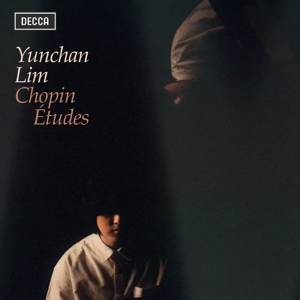
Frédéric Chopin (1810-1849)
Études, Op 10 (1833)
Études, Op 25 (1837)
Yunchan Lim (piano)
rec. 2023, Henry Wood Hall, London, UK
Decca 487 0122 [58]
Chopin’s Études probably suffer more than most from the connotations of their title. An étude or a study certainly sounds more academic than a nocturne or ballade but, Chopin being Chopin, these works are replete with poetry and colour despite their difficulties and focus on specific technical problems. For Chopin these technical focuses, arpeggios, thirds, sixths, octaves, inner voicings, etc. were merely another canvas for a rich tapestry of musical material and therefore it is a shame that these works are rarely treated with quite the same sensitivity as the other equally challenging but less academically titled works of his oeuvre. To my mind, only Alfred Cortot in his set from the mid-30s really understood the need to treat these pieces as music no less inspired than the op. 28 Preludes. Almost all other recordings have taken approaches that, while not necessarily lacking in feeling, have never married so successfully their technical demands with their intended effect.
I was hugely impressed with Lim’s recording of the Liszt Transcendental Études where he demonstrated not just striking technique but individuality and musicality, too. It may well be true to say that Liszt’s entire output suffers from the same issue as Chopin’s studies, in that his reputation as a virtuoso often precludes much of the subtlety, lyricism, and potential for colour in his writing. Comparing Lim’s Liszt with Claudio Arrau’s recording from the 1970s, it is quite clear that, while the older pianist is no longer in possession of the technique needed to execute such demanding works with a sense of ease, his command of sonority and story is far greater. This is not to denigrate Lim alone, as from Lazar Berman to Daniil Trifonov few pianists take the work back to its old Romantic routes instead mixing poetry and drama with a focus on the lyrical and virtuosic extremes, rather than fusing them throughout. Nevertheless, Lim, especially at such a young age, proves to be extraordinarily convincing; after all, when played with such élan, those pieces have a great capacity for excitement even without the true Romantic touch.
The same can be true of Chopin’s Études, at least to an extent – even more so than with Liszt, the foundation of Chopin’s musical style was poetic with clear influences of the Italian ‘bel canto’ and the need for, above all, a singing tone, a natural sense of line, and a rich palette of colour. While capitalising on the technical challenge can produce some thrilling moments, the artist can hold these works together really only if his command of the instrument reaches well beyond technical prowess. If we take the 7th étude from Op. 25 ‘cello,’ Lim skilfully emphasises the melodic line and executes the work flawlessly, yet I was left feeling as though something were missing. Listening to Cortot, the difference is readily apparent and in the more flowing tempo and freer handling of the melodic material the deference to Bellini (Norma, ‘teneri figli’ is referenced) is obvious. Then take the rising scales in the left hand at the centre of the piece which Cortot instinctively understands as a dramatic gesture, whereas Lim doesn’t quite find the shape and impetus to reveal that extra layer of narrative and drama.
When it comes to the issue of sonority, it is sometimes hard to blame the pianist. In the first half of the 20th Century Cortot already complained of over-bright pianos, and to counteract this preferred to play loudly while using the dampener pedal to create a sonorous but penetrating effect. This reliance on the soft pedal created a very different sonority from that of any modern pianist, in that it changed the basic timbral structure of brighter hues, giving way to darker ones which allowed him to build those elements of brightness upon a darker and richer base. The issue of timbre is not always given as much thought as it should be and, compounded with the fact that many modern pianos can tend towards over-brightness and brilliance, it is unsurprising that the effects of that entirely separate element of pianism are nowadays so often muted. Listen to any of Cortot’s Chopin or Gieseking’s Debussy to get a sense of how touch and skilful use of the pedals can create another dimension of expression. Lim does use colour and certainly varies his touch quite considerably, but where the gradation in light to dark is plainly present that rich multi-colour sound is mostly missing.
All that said, taken on its own terms, there is much to enjoy in Lim’s recording. At just 20 years old, his technique and maturity command respect. Tempi are well-judged and the playing unfailingly tasteful. He seems equally at home surmounting any of the various difficulties and still phrases well, taking time to make sure melodic lines are clearly separated from the texture. There are a few places where some more care might have been taken – a clipped phrase at the start of the ‘revolutionary’ étude, for instance – but in others, such as with the shimmering yet clearly melodically-led ‘aeolian harp’, this is as successful a more modern interpretation of these works as you will find.
While I wouldn’t want to be without Cortot’s recording of these works, most will want a modern recording and, in wonderful stereo sound, this is certainly a valid option. I do not find it quite as convincing or individual as his extraordinary Liszt études but then, there are very few recordings of Chopin’s sets which I find totally satisfactory.
Morgan Burroughs
Previous reviews: Marc Bridle (April 2024 Recording of the Month) ~ Stephen Greenbank (May 2024)
Buying this recording via a link below generates revenue for MWI, which helps the site remain free.



















